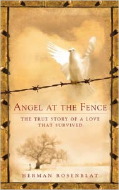
The story of how Herman Rosenblat first met his wife, Roma, was remarkable. Rosenblat was imprisoned as a child in the Buchenwald concentration camp. He claimed that Roma, a Jewish girl disguised as a Christian who lived in the nearby town, used to throw apples over the fence for him. Twelve years later, the two met in Coney Island and realized where they had previously seen each other. They fell in love and got married.
Rosenblat first shared this story in the mid-1990s, when he submitted it as an entry for a newspaper contest about "best love stories". He said he had been told to share the story, which he had kept secret for so many years, by his dead mother who appeared to him in a vision while he was lying in a hospital bed after being shot during a robbery.
The story subsequently received an enormous amount of attention from the media. Rosenblat and his wife appeared on the
Oprah Winfrey Show twice to tell it. Oprah declared it to be "the single greatest love story" she had ever heard. Rosenblat expanded the story into a book,
Angel at the Fence: The True Story of a Love that Survived, which was scheduled to be published in February 2009 by Berkley Books. A movie adaptation of the story was also planned.
However, as the story attracted more attention, skeptics raised questions about it. Other Buchenwald survivors insisted it could not be true because civilians were not allowed anywhere near the fence. Historian Kenneth Waltzer discovered that Rosenblat's wife had lived over 200 miles away from the camp.
In December 2009, Rosenblat admitted the story was not true. His publisher canceled the planned publication of the book. In a statement, Rosenblat explained, "My motivation was to make good in this world. In my dreams, Roma will always throw me an apple, but I now know it is only a dream."
Links and References

 The story of how Herman Rosenblat first met his wife, Roma, was remarkable. Rosenblat was imprisoned as a child in the Buchenwald concentration camp. He claimed that Roma, a Jewish girl disguised as a Christian who lived in the nearby town, used to throw apples over the fence for him. Twelve years later, the two met in Coney Island and realized where they had previously seen each other. They fell in love and got married.
The story of how Herman Rosenblat first met his wife, Roma, was remarkable. Rosenblat was imprisoned as a child in the Buchenwald concentration camp. He claimed that Roma, a Jewish girl disguised as a Christian who lived in the nearby town, used to throw apples over the fence for him. Twelve years later, the two met in Coney Island and realized where they had previously seen each other. They fell in love and got married.
Comments
These false narratives damage the history of the Holocaust and provide ground for the deniers and the revisionists.